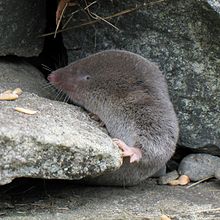Poisonous mammals
As toxic mammals are few species of three orders known. In addition, there are mammals that use defensive secretions that are not poisonous, but at least impairing defensive secretions , such as the skunks .
Orders
Primates
Some slow loris (such as the wet-nosed primate Nycticebus kayan from Southwest Asia and Indonesia) have a poison gland on their arm . They lick up the secretion and can apply it with their canines. This is probably not a poison, but an allergen . Fatal bite injuries have been reported. Therefore, their canines are shortened before they are kept at home. As a result of this procedure, many of the captured animals die. How the poison is formed in the body is not yet fully understood. Sequestration is suspected after consuming poisonous insects or spiders . In captivity, the toxicity levels decrease. Presumably, this venom bite was not developed to better prey, but to protect against predators as part of a Müllerian mimicry with cobras , whose appearance they also imitate.

Monotremes
In male platypus about 15 mm long are made in the heel spurs, which secrete a toxin produced in venom glands in the abdomen. The sexual dimorphism makes an interpretation of this system difficult.
Insect eater
Shrews
At least four species of shrew from the two genera water shrews ( Neomys with three species) and American short-tailed shrews ( Blarina with four species) produce the poison Blarina toxin (BLTX) in the lower jaw , presumably for the easier subjugation of prey animals.
Weevil
Two types of slit weevil , Cuban slit weevil ( Solenodon cubanus ) and Dominican slit weevil ( Solenodon paradoxus ) produce a neurotoxin in the lower jaw salivary gland . The poisonous saliva is channeled through a deep groove on the inside of the second lower incisor into the wounds of even relatively large prey.
history
The earliest scientific record of a poisonous mammal dates back to a water shrew by Topsell in 1607.
literature
- Rodrigo Ligabue-Braun, Hugo Verli, Célia Regina Carlini: Venomous mammals: a review. In: Toxicon , Volume 59, No. 7, 2012, pp. 680-695, doi : 10.1016 / j.toxicon.2012.02.012 .
Individual evidence
- ^ A b c K. Anne-Isola Nekaris, Richard S. Moore, E. Johanna Rode, Bryan G. Fry: Mad, bad and dangerous to know: the biochemistry, ecology and evolution of slow loris venom. (PDF) In: J Venom Anim Toxins incl Trop Dis , Volume 19, No. 1, 2013, pp. 21-31.
- ↑ Sonja Krane, Yasuhiro Itagaki, Koji Nakanishi, Paul J. Weldon: "Venom" of the slow loris: sequence similarity of prosimian skin gland protein and Fel d 1 cat allergen. In: Naturwissenschaften , Volume 90, No. 2, 2003, pp. 60-62, doi : 10.1007 / s00114-002-0394-z .
- ↑ M. Walker: Primate species: new slow loris found in Borneo . BBC News, December 13, 2012.
- ↑ E. Johanna Rode-Margono, M. Rademaker, Wirdateti, A. Strijkstra, KAI Nekaris: . Noxious arthropods as potential prey of the Javan slow loris venomous (Nycticebus javanicus) in a West Javan volcanic agricultural system In: Journal of Natural History , 49, No. 31–32, 2015, pp. 1949–1959, doi : 10.1080 / 00222933.2015.1006282 .
- ↑ Guillaume Lecointre, Hervé Le Guyader: Biosystematics. Springer-Verlag, 2006, ISBN 978-3-540-29979-0 , p. 512 ( limited preview in the Google book search).
- ↑ Yael T. Aminetzach, John R. Srouji, Chung Yin Kong, Hopi E. Hoekstra: Convergent Evolution of Novel Protein Function in Shrew and Lizard Venom. In: Current Biology. Volume 19, issue 22, December 1, 2009, pp. 1925–1931, doi: 10.1016 / j.cub.2009.09.022
- ^ R. Ligabue-Braun, H. Verli, Carlini CR: Venomous mammals: A review . In: Toxicon . 59, No. 7-8, 2012, pp. 680-695. doi : 10.1016 / j.toxicon.2012.02.012 .
- ↑ RE Topsell: History of foure-footed beasts. Jaggard, London 1607.


